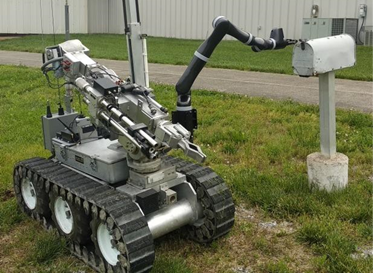April 7, 2020
Powerful explosives can be made from common consumer goods,
like pool sanitizers, fertilizers and paint removers, that are bought and sold
every day in the United States. In the hands of the wrong people, these basic
materials can be used to make improvised explosive devices. Homemade bombs pose
a credible threat and can cause mass casualties, infrastructure damage and
spread fear among affected communities.
Reliance upon bomb squads comes at the price of placing
members in dangerous environments. With that in mind, the first responder
community identified an improved robot as a critical need for bomb and
explosive ordnance disposal (EOD).
In 2019, the Department of Homeland Security (DHS) Science
and Technology Directorate (S&T) developed a new accessory arm as part of
the Upgrade Explosives Ordnance Disposal Robot Project, a joint venture between
S&T, Israel’s Ministry of Public Security (MOPS) and the Israel National
Police Bomb Disposal Division (INPBDD).
“The goal of this collaboration is to assist bomb
technicians in both countries to refine and enhance their ability in render
safe procedures,” said Byung Hee Kim, Program Manager for S&T’s Response
and Defeat Operations Support (REDOPS) program.
The robot accessory arm is part of S&T’s ongoing work
with MOPS to facilitate research, development, testing and evaluation
activities and deliver enhanced capabilities to law enforcement and public
safety personnel in both countries.
A New Robot Accessory Arm
S&T worked with its Israeli counterparts to integrate
Remotec Inc.’s Andros Wolverine 6X6 and accessory arm system. Since a suitable
option for the secondary manipulator was available as an off-the-shelf product,
there was no need to develop a new robotic arm. The team selected the Jacob®
arm produced by Kinova Inc., a robotics manufacturer serving the medical and
first responder markets. The Jaco arm was tested and combined with a
high-strength finger gripper from Robotiq. The Remote Accessory Arm was then
integrated with the Wolverine bomb disposal robot as a secondary, highly
dexterous small arm.
Together, the Kinova Remote Robotic Manipulation System
enabled more precise video-guided manipulation of potentially hazardous
materials using the Remotec Andros platform. Upgraded movements were adapted
with the addition of a video camera inside the arm so the finger assembly could
provide the remote operator with a constant stream of the inspected object. The
team incorporated additional enhancements throughout the prototyping process,
such as a standalone radio for remote-control operations, a mechanical adaptor
for installing the arm on an Israeli or U.S. robot, and camera unit including a
laser pointer device within the new manipulator arm. These improvements should
allow users to perform multiple delicate tasks—such as unzipping a suspicious
backpack, extracting detonators, opening doors, using tools such as knives,
samplers, and scissors—with greater ease. And the arm is designed to better
mimic movements of a bomb technician for quicker device disabling.
Kinova Executive Vice President François Boucher noted that
“the complementary products proved better when paired together as an integrated
system for significantly increased capabilities.”
Technician evaluators noticed how the ability to remotely
change tools down-range significantly reduced the time required to disable a
bomb, in comparison with the use of one arm. In addition, the second arm
preserved forensic evidence at the scene while disabling the bomb, keeping it
intact and avoiding detonation.
“The arm and its accessory system give bomb techs new
capabilities and increased dexterity, so instead of having another robot come
and assist with disabling a bomb, they will have another appendage right there
to help them negotiate whatever task they need to,” said Kim. “This arm makes
them work more efficiently and quickly and saves money.”
Testing and Results
In April 2018, S&T’s REDOPS program conducted a training
exercise in Israel with U.S. public safety bomb squads, the INPBDD and industry
representatives from the U.S., Canada and Israel. Technicians exchanged
knowledge and received feedback from the end users based on experiences
utilizing the manipulator on bomb disposal render safe procedure scenarios to
result in a high caliber operational prototype.
“This level of visibility on an S&T project shows the
value of its partnerships and the work S&T does in support of the DHS
mission,” Kim explained.
The following year, S&T and the Israelis successfully
demonstrated and delivered a prototype of the accessory arm robot in Fairfax,
Virginia, where many state police departments and industry companies
participated, including the Michigan State Police, New Jersey State Police,
Fairfax County (Virginia) Police and DAGER Technology. The robot accessory arm
on an Andros Wolverine Robot performed a series of joint operational scenarios,
leading to the development of a product tailored to the operational requirements
of bomb squads.
Future Robotics Developments
Prototypes of the accessory arm Andros Wolverine Robot were
initially deployed to the INPBDD, the Michigan State Police Bomb Squad, and the
New Jersey State Police Bomb Squad, who continue to share feedback as they use
the technology operationally in the field.
Remotec and Kinova have since agreed to distribute the
Kinova Remote Robotic Manipulation System, which is now commercially available.
“The commercialization of the Robot Accessory Arm is a success for DHS and more
importantly for the bomb squads that have gained a new life-saving technology,”
said Kim.
Under the agreement, Remotec sells the Kinova product as a
remote option on the Andros platform to the U.S. first responder and law
enforcement markets. Remotec also provides customer service, training and
technical support for this new capability.
For more information about the Robot Accessory Arm and
REDOPS, contact first.responder@hq.dhs.gov.







No comments:
Post a Comment